Abstract
Today, the application of green materials in the building industry is the norm rather than the exception and reflects an attempt to mitigate the sector’s environmental impacts. Mass timber is growing rapidly in the construction field because of its long span, speed of installation, lightness and toughness, carbon sequestration capabilities, renewability, fire rating, acoustic isolation, and thermal resistance. Mass timber is close to overtaking steel and concrete as the preferred material. The endeavor of this research is to quantitatively assess the ability of this green material to leverage the abatement of carbon emissions. Life cycle assessment (LCA) is a leading method for assessing the environmental impacts of the building sector. The recently completed Adohi Hall mass timber building on the University of Arkansas campus was used as a case study in an investigation to quantify greenhouse gas (GHG) emissions throughout the construction phase only. The energy used in building operations is the most dominant source of emissions in the building industry and has galvanized research on increasing the efficiency of building operations, but reduced emissions have made the impacts of embodied carbon (EC) components more noticeable in the building life cycle. While most studies have focused on the manufacturing stage, only a few to date have focused on the construction process. Consequently, few data are available on the environmental impacts associated with the installation of mass timber as a new green material. The present study began with the quantification of the materials and an inventory of the equipment used for construction. Then, this study determined the EC associated with running the equipment for building construction. The GHG emissions resulting from the transportation of materials to the site were also quantified. Based on data collected from the construction site, the results of this study indicate that earthwork ranks first in carbon emissions, followed by mass timber installation and construction. In third place is ready-mix poured concrete and rebar installation, followed by Geopiers. A comparison of these results with those in the existing literature shows that the EC generally associated with the building construction phase has been underestimated to date. Furthermore, only emissions associated with the fuel usage of the main equipment were considered.
1. Introduction
1.1. Operational Carbon (OC) and Embodied Carbon (EC)
Global warming has emerged as one of the most significant global environmental issues [1,2]. The construction industry contributes a large amount of carbon emissions in various ways throughout the whole life cycle of buildings [3]. Building emissions are categorized into two groups: OC and EC [4,5]. Buildings’ OC values incorporate emissions associated with building occupancy use, including heating, lighting, and air conditioning. EC consists of emissions from the production and transportation of building materials to the site; the construction process; and demolition, recycling, or reuse at the end of the building’s life [4,5].
The strongest environmental impacts associated with the building sector occur during the buildings’ operation phase [6,7,8,9,10,11,12,13]. Research efforts towards improving energy efficiency and using cleaner sources have led to reductions in buildings’ OC values, which have correspondingly scaled up EC emission quantities. However, there remains limited research to address the EC reduction in buildings, as discussed below.
The carbon footprint (EC) from the construction process is relatively small compared to that of the production process of building materials [14]. Accordingly, attention has been given to minimizing the EC from the production of building materials, while the EC associated with construction sites remains poorly explored [15,16,17]. For example, Mazur et al. [18] neglected the carbon footprint of the construction phase in their study. Another study by Becker et al. [19] focused only on the EC in the material production stage. Fischer et al. [20] compared a concrete building to a mass timber building through a whole-building life cycle assessment (LCA) study and deliberately excluded the construction phase. Wu et al. [14] interviewed 30 contractors, and only 2 of them (6.67%) considered the environmental benefits related to the job site’s layout. Due to the large size of the building sector, however, the GWP associated with the construction phase is remarkable when scaled up. This underscores the fact that more research is needed to investigate emissions from construction sites, following a life cycle perspective, to identify the areas in which environmental impacts are most significant.
1.2. Low-EC Construction Strategies
A cursory review of the research on the environmental impact of EC generated from construction sites provided the following: Joseph et al. [15] stated that major on-site carbon emissions are due to the operation of equipment and construction machinery. Prefabrication and the use of biodiesel for on-site machines were presented as two low-carbon strategies by Padilla-Rivera et al. [21]. A study by Guggemos et al. [22] concluded that carbon reduction can be achieved through the appropriate management of inventories. For example, temporary materials like wooden forms and steel shoring can be reused for multiple projects, and old equipment can be replaced with new machinery that achieves better emissions standards. Yan et al. [23] pointed to the equipment’s operations as the main source of carbon emissions during construction. Construction process optimization is another low-carbon strategy noted by Akbarnezhad and colleagues [4].
1.3. EC Metrics Comparison
A detailed exploration of the existing literature reveals the carbon emissions per square meter of floor area to be the preferred metric for comparing various materials or buildings with categorical activities such as housing and offices. A study by Liang et al. [24] showed that the greenhouse gas (GHG) emissions in the construction stage (module A5) of the studied mass timber and concrete buildings were 10 and 12 kg CO2 eq/m2 of floor area, respectively, when using the Athena method [25] for a rough estimation of this life cycle stage. The study uniquely reported on the fossil fuel consumption related to the installation process of building materials. The energy utilization examined consisted of using diesel fuel to power cranes employed for tasks such as lifting mass timber and pouring or pumping concrete. Notably, the study excluded several other elements inherent to the broader construction process, including groundwork preparation, assembly by labor, landform and terracing, and other elements.
In the category of housing buildings, in a study on a multifamily mass timber dwelling in the city of Granada, Spain, Vidal and colleagues [1] determined a quantity of 65 kg CO2 eq/m2 of floor area for module A5. Specifically, this metric resulted from the consumption of 1878 kWh of electricity and 9000 L of diesel during the building construction phase. Vidal et al.’s study is also based on a 50% waste reduction compared to conventional construction systems. An LCA study conducted by Gustavsson et al. [26] reported 27 kg CO2 eq/m2 of floor area associated with the construction phase of an eight-story wood-framed apartment building. Based on the existing literature, the assumption of the study stipulates that on-site construction necessitates an estimated energy consumption of 80 kWh/m2. Another study conducted by Cole [27] showed on-site GHG emissions associated with the construction of structural building assemblies to be 5–20 kg CO2 eq/m2, 0.4–1 kg CO2 eq/m2, and 0.8–2.5 kg CO2 eq/m2, respectively, for cast-in-place concrete, steel, and wood. It should be noted that this study also included emissions associated with fuel consumption due to worker transportation to and from the building site. EN 15978 [28], however, excludes emissions due to worker transportation to and from the building site. Another study by Chen et al. [29] indicated the average carbon emissions during the construction phase of buildings in China to be 7 kg CO2 eq/m2. The resulting metrics from the above-mentioned studies show wide variation, depending on the adopted assumptions and the consideration or exclusion of other factors.
1.4. Variation in EC Metric Outputs
Based on the above-reviewed literature, research gaps remain, particularly in the establishment of a comprehensive comparative analysis between various buildings at the construction stage through a coherent LCA approach. As indicated, the different considerations and assumptions adopted from one study to the next result in wider discrepancies between the resulting metrics. In addition, these approaches depend on generalized approximations of fuel energy usage, neglecting factors like equipment specifications and the actual working hours at the construction site.
This study emerges from the need to understand the carbon footprint of on-site buildings constructed with mass timber within the context of a holistic LCA. Adohi Hall is used as the case study to appraise the GWP resulting from the construction procedures employed in erecting the building. While the above-mentioned studies rely mostly on broad and publicly available estimations of fuel energy consumption, this research seeks to improve precision by carefully considering specific factors and incorporating detailed information about equipment specifications and the actual duration of working hours at the construction site. This methodological adjustment is designed to yield a more nuanced and accurate determination of the environmental impact and to identify hotspots for the most significant environmental impacts, all within the construction process.
2. Materials and Methods
The approach method selected for this case study is essentially quantitative, resulting from the adopted life cycle analysis tool. This article provides a study of the carbon footprint of Adohi Hall during the construction stage (A5). Section 2.1, Section 2.2 and Section 2.3 provide a detailed description of the method.
2.1. Quantitative Method
LCA is the quantitative approach employed to determine the carbon footprint associated with mass timber construction work. In this analysis, LCA is performed using numerical data directly obtained from the construction team. Among the various tools available for assessing the environmental consequences of products and structures, LCA is the most comprehensive, encompassing all impacts occurring over the entire life cycle of a product [30]. LCA can address all aspects of a system, whether they involve input resources like energy and materials or outputs like emissions [31]. Through LCA, it becomes possible to pinpoint critical areas where a product system has the most significant environmental impacts, offering the potential for targeted environmental mitigation efforts [32].
ISO 14040:2006 [33] outlines the fundamental principles and framework for conducting an LCA, while ISO 14044:2006 [34] specifies the corresponding requirements and offers guidance for the process. Consequently, conducting an LCA for a specific project involves four key steps: defining the goal and scope, conducting an inventory analysis, performing an impact assessment, and interpreting the results.
There has been a notable proliferation of software designed to facilitate the execution of LCA projects. Prominent examples include SimaPro (Version 9.5.0.0), One-click LCA (Version 4.0.6), Umberto (Version 11), and Open LCA (Version 2.0), among others [35]. SimaPro [36] has garnered considerable recognition as one of the leading LCA programs within the academic sphere. This can be attributed to its utilization of scientifically validated databases and globally accepted methodologies. SimaPro [36] is an LCA tool developed to comprehensively evaluate the environmental burden imposed by a product or system across its entire life cycle. SimaPro contains extensive libraries that encompass life cycle inventory (LCI) datasets and internationally accepted methodologies; this tool enables the calculation of predetermined environmental impacts associated with materials and processes. Within this methodology, analysis is conducted by utilizing the primary data directly obtained from the construction company to ensure a robust and accurate assessment (Nabholz Construction Corp. (Conway, AR, USA)). This quantitative LCA also leverages secondary datasets from publicly available databases, e.g., the U.S. Life Cycle Inventory (USLCI) database [37] and the Ecoinvent database [38].
Additionally, TRACI (Tool for Reduction and Assessment of Chemicals and Other Environmental Impacts) [39] was chosen as the impact assessment method within the SimaPro LCA modeling framework. TRACI was selected as the modeling engine because it provides a methodology developed by the Environmental Protection Agency (EPA) specifically for a North American context.
2.2. Goal, Objectives, and Scope
This study aims to locate the primary environmental impact hotspots within the construction process. The central objective is to quantify the EC emissions from the construction site and assess the resulting GWP impacts during the erection of the Adohi Hall mass timber structure. This analysis considers specific factors, such as detailed information about equipment specifications and the actual duration of working hours at the construction site. The on-site electricity used for the workers’ miscellaneous activities with a short duration, such as lighting, cooking, local heating, and cooling, is not included in the scope of this study due to the absence of data. Given the substantial influence of the building industry on global warming, this research exclusively concentrates on the parameter GWP, measured in kg CO2 eq. The functional unit adopted for this study is 1 m2 of gross floor area.
2.3. System Boundaries
Figure 1 illustrates the various stages of the building’s life cycle in accordance with the EN 15978 standard [28]. The present investigation incorporates the system boundary that encompasses the gate to completion of the construction process. Specifically, the scope includes transportation associated with the construction phase, module A4, and the building erection process, module A5, as indicated in Figure 1.

Figure 1.
Building life cycle stages (Adapted from [28]).
Module A4 of the building life cycle stage defined by the standard [28] is dedicated to evaluating the environmental impacts associated with the transportation of materials and construction equipment to and from the building site. Module A5 instead encompasses an extensive range of activities that involve groundwork, the installation of products into the building, heating/cooling and electricity uses for temporary housing on-site, the storage of products, the transportation of materials and equipment within the site, water usage for the cooling of construction machinery or on-site cleaning, and waste management, including hauling waste from the building site. The scope of module A5 extends to cover all relevant processes until final disposal or until the end of the waste state is achieved.
The limitations of the present study are discussed below. In module A4, the scope is restricted to the transportation of materials, while the transportation of equipment is excluded. Likewise, in module A5, only groundwork and the installation of products into the building are covered. Notably, this study’s scope is confined to the building’s foundations and structure, including the building’s columns, beams, shear walls, and slabs. Moreover, this study excludes on-site water and electricity consumption because the data are not available.
3. Description of the Adohi Hall Mass Timber Building
The mass timber chosen for Adohi Hall could represent an exemplar for using the same material in other buildings on campus and is expected to facilitate a more sustainable environment with fewer carbon emissions.
Adohi Hall, a recently constructed residential building, stands as the largest mass timber structure for college residences in the United States. Spanning an impressive 200,000 square feet, this building accommodates 708 students. The building’s layout is characterized by its multifunctionality, with the basement and ground floors serving diverse purposes, e.g., storage areas, small studios, and assembly spaces. The upper levels consist of student residential units complemented by additional supporting areas. Adohi Hall, with its six wings and five floors, predominantly relies on cross-laminated timber (CLT) slabs supported by glue-laminated (Glu-lam) columns and beams. However, the basement and ground floor sections incorporate concrete slabs along with a combination of steel and concrete columns and beams. The mass timber components utilized in Adohi Hall are manufactured at the Binderholz factory in Graz-Styria, Austria, and transported to the construction site situated on the University of Arkansas campus in Fayetteville, Arkansas [40]. Notably, the soil conditions at the site of Adohi Hall are weak and unstable, which necessitates the application of Geopier foundations. This technique involves enhancing the load-bearing capacity of the soil by inserting piers made of stone aggregates coated with concrete cement into the ground.
Building Construction Phase
Based on interviews with the construction team, the various tasks involved in the erection of the structure were categorized into four main groups: 1. earthwork; 2. Geopier installation; 3. on-site reinforced concrete pouring; and 4. mass timber erection (Figure 2).

Figure 2.
Job site categories.
The term earthwork denotes the task of removing substantial amounts of rock or soil, which is usually necessary for constructing foundations and excavating. Geopier constitutes a ground improvement methodology that entails the placement of piers within the soil to augment the structure’s load-bearing capacity. A reinforced concrete project includes the foundations, shear walls, concrete slabs, columns, and beams, in addition to elevators and stair towers. A mass timber job refers to the erection of Glu-lam columns, beams, and CLT floors. Table 1, Table 2, Table 3 and Table 4 present the equipment involved with each task.

Table 1.
Equipment operation for earthwork plus hauling soils, gravel, and spoils from-to the site.

Table 2.
Equipment used for Geopier plus hauling soils, gravel, and spoils from-to the site.

Table 3.
Equipment operation for the concrete job plus equipment for the transportation of rebars and concrete to the site.

Table 4.
Equipment operation for mass timber installation and equipment for transportation of Glu-lam and CLT to the site.
Figure 3 presents data on the total equipment hours for each job category. Here, the results reveal that concrete jobs have the highest recorded equipment operation hours, indicating a significant level of equipment utilization. Conversely, the Geopier work corresponds to comparatively limited equipment usage.
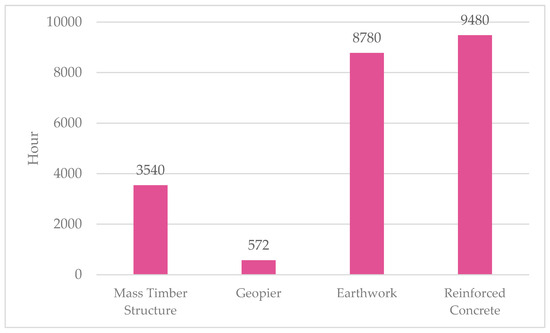
Figure 3.
Total equipment operation hours for each job category.
4. LCA Modeling in SimaPro
SimaPro version 9.5.0.0 was applied for the LCA modeling in this study. In this investigation, the USLCI database, which includes LCI datasets specific to the United States, was employed whenever the requisite data were accessible. If the desired data were not available in the USLCI, the Ecoinvent v. 3.7.1 database was employed. Ecoinvent, an initiative pioneered by the Swiss Centre for Life Cycle Inventories [41], was initially developed in Europe but incorporates a wide range of materials and processes that are representative not only within Europe but also across various geographical regions globally.
The database associated with building equipment operations was used to model the project machine operation. This database records the operational service of a high-load factor machine operating with diesel in construction. Three engine power ranges are provided by the database: from 18.64 kW to 74.57 kW, under 18.64 kW, and over 74.57 kW. Depending on the equipment used on-site, the appropriate engine power range is selected. The elements considered in operation include the infrastructure, lubricating oil, fuel consumption, air emissions, and waste (Ecoinvent v. 3.7.1 database). The appropriate database is also used for the transportation of materials, combining different modes like trucks, rail, and container ships for sea crossing. Notably, this study is exclusively concentrated on the transportation of materials, while equipment hauling falls beyond the scope of this investigation and will be examined in a forthcoming study. Figure 4 shows an example of the LCI associated with SimaPro in a job category such as earthwork. In the same database, other job categories are included in the model, including Geopier installation, concrete, and mass timber installation.

Figure 4.
Sampled LCIs chosen for earthwork. Similar LCIs were also chosen for Geopiers installation, concrete pouring, and mass timber installation.
5. Analysis of the Results
The LCA results show that a total of 3211 tonnes of CO2 eq carbon emissions were generated from the construction of Adohi Hall within the defined boundary system and activities included in modeling the LCA. After conversion to the chosen functional unit, every square meter of Adohi Hall, built during the construction phase, was found to release 173 kg of CO2 eq emissions into the atmosphere.
The data presented in Figure 5 highlight the carbon emissions associated with the equipment’s operations during the construction phase. Specifically, the equipment operation is responsible for a total of 2460 tonnes of CO2 eq, which represents approximately 70% of the total GHG impact generated during the construction of Adohi Hall. This result suggests that construction equipment, such as excavators, bulldozers, and cranes, plays a significant role in contributing to carbon emissions during the construction phase.
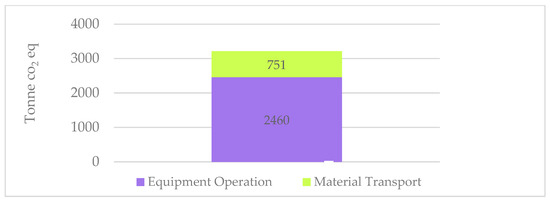
Figure 5.
Carbon footprint from material transport and equipment operations during the construction process of Adohi Hall.
The remaining 30% of GWP impacts during the construction phase of Adohi Hall are associated with material transportation, which amounts to 751 tonnes of CO2 eq emissions. This result indicates that the transportation of materials to and from the construction site is also a significant contributor to carbon emissions during the construction phase.
Figure 6 shows the carbon footprints of different types of construction work. According to the results, the largest carbon footprint, which represents 41% of the total impact, is associated with earthwork. The analysis also indicates that mass timber erection and concrete jobs are, respectively, responsible for 31% and 26% of the total impact, while only 2% of the GWP is associated with Geopier work.
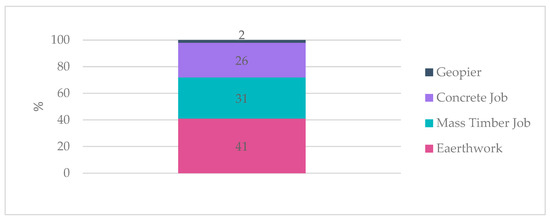
Figure 6.
Contribution of each job category to the carbon footprint during the construction process of Adohi Hall.
Figure 7 illustrates the contribution of the transportation and construction phases to the carbon emissions of each job category. Despite the significant contributions of concrete jobs to overall carbon emissions, the impact of concrete transportation on environmental performance here is considered insignificant due to the proximity between the concrete production location and the construction site, which reduces the traveled distance and associated emissions.

Figure 7.
Contribution of each job category to the carbon footprint from material transport and equipment operations during the construction process of Adohi Hall.
On the other hand, Figure 7 shows that the carbon emissions related to mass timber hauling are significant, as indicated in a previous article [40]. This result is primarily due to the importation of mass timber from Austria and the long-distance hauling required from Europe to the United States [40]. The carbon emissions associated with the transportation of materials for the earthwork also remain significant, despite the hauling of soils, gravel, and spoils over short transportation distances. This result is attributable to the substantial quantity of materials required for earthwork, totaling 72,209 tonnes of soil, gravel, and spoils.
Figure 8 indicates the contribution of equipment with different power in each job category. The graph confirms that higher carbon emissions are more strongly associated with earthwork than with concrete jobs, despite the former having lower equipment operation hours than the latter (Figure 3). Even though the total equipment hours of earthwork jobs are lower than those of concrete jobs, higher-power machines with intensive diesel fuel use are preferred for on-site earthwork jobs.
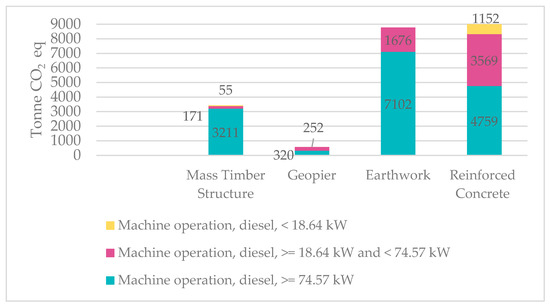
Figure 8.
Contribution of equipment with different power levels to the carbon footprint in each job category.
There are, however, uncertainties linked to the equipment load factor data gathered from the construction company foremen during work hours; these data are extremely important for the present LCA modeling. The load factor, denoting the proportion between the actual load drawn by a piece of equipment during operations and its maximum load capacity, is relevant in this context. Leveraging these uncertainties, the present study adopts three discrete assumptions: high-load, low-load, and steady-state equipment operations throughout the duration of work hours. Figure 9 illustrates the GWP for mass timber structure equipment operations on a construction site, assuming three different load factors for equipment use. The obtained results are 132 kg CO2 eq/m2, 91 kg CO2 eq/m2, and 53 kg CO2 eq/m2, respectively, for the three different load factors of the equipment.
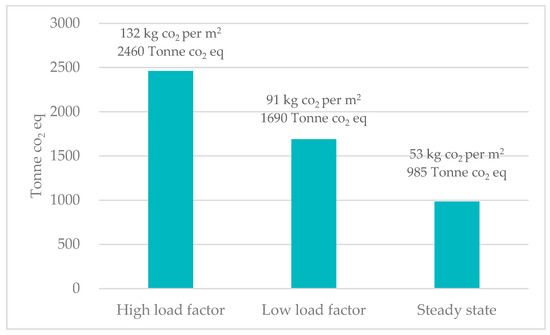
Figure 9.
GWP for mass timber structure equipment operations on a construction site, assuming three different load factors for equipment use.
6. Comparison of Modeling Scenarios
As shown in Figure 5, the findings indicate that the cumulative amount of 3211 tonnes of CO2 eq carbon emissions generated throughout the construction phase of Adohi Hall in the designed LCA model corresponds to about 173 kg of CO2 eq emissions per square meter released to the atmosphere.
The prevailing approach in most existing whole-building LCA (WBLCA) studies conducted using commercial WBLCA tools involves modeling the construction phase only by lumping the overall estimated fuel energy consumption during the building’s construction. This commonly applied estimation of fuel consumption is primarily based on the height of the building and the total weight of the materials. Specific considerations related to equipment specifications and their operational hours at the construction site are typically not considered in the modeling. In the end, such models result in wider discrepancies between the carbon emission quantities.
For demonstration purposes, a comparison of the two approaches is examined to closely quantify the EC of the mass timber structure construction site. Scenario 1 includes the outcomes derived from detailed modeling of the construction project, incorporating data collected from the construction team on the equipment specifications and operational hours. In Scenario 2, the EC value attributed to the construction phase is solely focused on diesel fuel consumption throughout the building construction process, as provided by the same construction team. As shown in Figure 10, Scenario 1 yields a four-times higher GWP impact compared to Scenario 2, in which only diesel fuel consumption is modeled for the A5-stage construction.
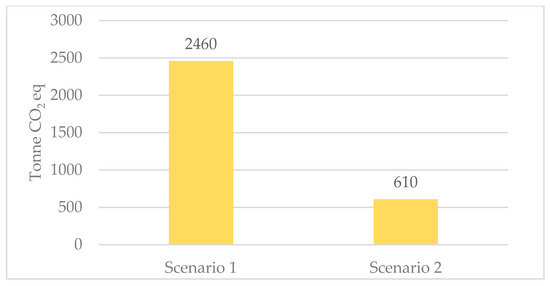
Figure 10.
Comparing two scenarios for calculating GWP from the mass timber structure construction site equipment impact: Scenario 1. Modeling based on the surveyed equipment used and operational hours during the construction of Adohi Hall; Scenario 2. Modeling is based on the total diesel fuel consumption during construction.
7. Discussion
The breakdown of carbon footprints across different construction activities, as illustrated in Figure 6, is valuable in distinguishing between areas of focus for enhancing sustainability. First, after steel works, earthwork emerges as the highest contributor, accounting for a substantial 41% of the total impact (Figure 6), which agrees with the findings of Chen et al. [29]. This result is primarily due to the high-powered machinery used in earthwork. In addition, the substantial volume of materials required for earthwork necessitates extensive transportation, resulting in substantial fuel consumption and GHG emissions. Second, optimizing the operating hours of construction machinery and equipment for earthwork jobs was identified as a crucial strategy for decarbonizing construction sites and improving overall efficiency.
Figure 7 illustrates the dynamic interplay between transportation and construction activities, revealing contrasting impacts for different job categories. The minimal impact of concrete transportation, despite concrete jobs being commonly known to significantly contribute to overall emissions, and conversely, the high impact of hauling of mass timber products, highlights the importance of considering the entire life cycle with site-specific factors. This finding prompts a reevaluation of the conventional emphasis on specific construction activities and advocates for a holistic approach to environmental impact assessment.
The influence of equipment power on carbon footprints, as depicted in Figure 8, challenges assumptions regarding the direct correlation between equipment operation hours and emissions. The higher carbon emissions associated with earthwork, despite having lower operation hours compared to concrete jobs, underscore the need for a detailed understanding of equipment specifications and fuel consumption patterns. This insight is important for devising targeted interventions to minimize emissions from high-powered machinery.
The uncertainties connected with equipment load factors add a layer of complexity to LCA modeling. Figure 9 provides a transparent exploration of the potential variations in GWP based on different load factor assumptions. This analytical approach enables a more comprehensive interpretation of the results, emphasizing the importance of sensitivity analyses and scenario planning in LCA studies.
The comparison of the modeling scenarios in Figure 10 highlights the discrepancies arising from simplified models that overlook detailed equipment specifications. Scenario 1, incorporating granular data on equipment use, yields a significantly higher GWP impact compared to that in Scenario 2, which solely considers diesel fuel consumption. This comparison underscores the importance of precision in modeling and the potential ramifications of oversimplified approaches in estimating carbon emissions, with most relying on aggregated estimations of fuel energy consumption, overlooking equipment specifications and operational hours at the construction site.
Figure 11 compares the results of this study with those of similar studies that focused on carbon emissions associated with the construction phase (mentioned above). The graph shows, in the case of Adohi Hall, the results of Scenario 2 modeling based on diesel fuel consumption during construction totaling 33 kg of CO2 eq emissions per square meter, which is in the range of existing studies. The detailed modeling approach (Scenario 1) considering equipment specifications and operational hours results in GWP impacts that are four-times higher than those of the approach relying solely upon on-site fuel energy consumption. This study shows that much higher emissions would result from this phase if the ISO standard 14044 [34] for the A5 stage were closely followed to model detailed activities in the WBLCA analysis.
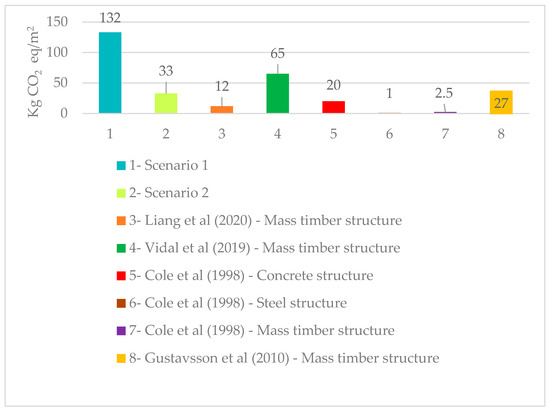
Figure 11.
Comparing the results of this study with those of other studies on CO2 emissions caused by the construction phase. Scenario 1. Modeling based on the surveyed equipment used and operational hours during the construction of Adohi Hall; Scenario 2. Modeling based on diesel fuel consumption during construction [1,24,26,27].
This discrepancy arises from primarily focusing on recording fuel consumption linked to main equipment such as tower cranes while disregarding the fuel consumption of other equipment. However, the cumulative total of all these fuel usages translates into a significant overall impact. Furthermore, by concentrating solely on fuel consumption, we inadvertently overlook the broader effects encompassing equipment production, road maintenance, and other factors included in the equipment LCI datasets and transfer them into the cumulative environmental impacts in construction stage A5.
Limitations
The University of Arkansas campus provided the electricity used on site. The absence of metering to monitor on-site consumption made it impossible for the construction team to provide such data to the research team. Likewise, the equipment transportation to the site was not included due to the inaccessibility of the data. Consequently, the exclusion of electricity and equipment overhauls from this study resulted in a slightly lower carbon footprint. Electricity is mainly used for small tasks such as lighting, cooking, and short-duration heating and cooling for the workers and staff.
8. Conclusions and Future Research
To conduct a more accurate assessment of energy consumption and GHG emissions in the building’s construction phase, an assessment model based on a detailed analysis of the construction phase was developed. Toward this end, the present study established a GHG emissions database for construction material transportation to the site as well as construction equipment operation. The factors related to the construction phase, such as equipment specifications and the types of transportation equipment based on the materials’ characteristics, were considered in the developed model. To review the usability of the developed model, the Adohi Hall mass timber building was used as a case study.
The aim of this article was to provide a comprehensive approach for carbon footprint and resource consumption during the construction phase in the context of a university student residential building. Using advanced research tools, a detailed analysis of a mass timber structure was carried out during the construction process. The research process was complemented by an LCA and an audit of on-site data related to equipment and fuel to estimate GHG emissions throughout the construction phase of the building.
This study compared various categories of activities in the construction phase: 1. earthwork; 2. Geopier installation; 3. concrete on-site pouring; and 4. mass timber erection. An analysis of the carbon emissions enabled us to rank the four categories and identify the key factors influencing the carbon footprint. Among them, earthwork yielded much larger carbon emissions. Moreover, a comparison of the two scenarios of data acquisition for determining carbon emissions during the construction phase confirmed that the directly recorded data from the site recorded four-times higher carbon emissions (kg CO2 eq/m2) compared to the use of the publicly available data. This higher GWP during the construction of a mass timber building confirms the importance of accurately determining the carbon footprint at various LCA stages, which is key to achieving sustainability goals and mitigating climate change. Although our research focused on material transportation, equipment operation, and hours of work, the electricity provided during construction to serve the needs of the workers and staff was overlooked due to the unavailability of data. This factor is intended to be an important consideration in future research.
Ultimately, this publication provides valuable information and conclusions for the scientific community, designers, and construction professionals and paves the way for further research aimed at the development of a comprehensive approach to evaluate carbon emissions during the construction phase and to minimize variability in LCA analyses. The increased availability of data is an important factor in better assessing and achieving greener and more sustainable building solutions, which is extremely important in the context of climate change and environmental protection. This narrow and deep study of the construction phase is meant to achieve a better comprehension of the factors influencing carbon emissions. Further research is also needed to explore streamlined construction practices through lean techniques as another area of carbon reduction that could benefit the LCA community.
Author Contributions
Conceptualization, M.H. and T.M.; methodology, M.H., T.M. and H.G.; software, M.H.; validation, M.H., T.M. and H.G.; formal analysis, M.H.; investigation, M.H.; resources, M.H.; data curation, M.H.; writing—original draft preparation, M.H.; writing—review and editing, M.H., T.M., and H.G.; visualization, M.H.; supervision, T.M. and H.G.; project administration, T.M.; funding acquisition, T.M. and H.G. All authors have read and agreed to the published version of the manuscript.
Funding
This research was funded by the Forest Products Laboratory of the U.S. Forest Service (FPL-1500).
Institutional Review Board Statement
Not applicable.
Informed Consent Statement
Not applicable.
Data Availability Statement
Data are contained within the article.
Acknowledgments
The authors acknowledge Chris Baribeau, AIA, Modus Studio, Leanne Baribeau, AIA, Architect, Modus Studio, Frank M. Allison, PE, President, Engineering Consultants Inc., and Alex Font, PE, Senior Project Engineer, at Engineering Consultants Inc. (Little Rock, AR, USA) for their help and support in providing the Revit model, the structure drawings, and related building material information. Special thanks go to Marty Schmidt, Nabholz Construction Superintendent, and Tyler Meenen at Nabholz Construction (Conway, AR, USA) for gathering and organizing data related to Adohi Hall’s construction and equipment. Tom S. Chung, FAIA, Leers Weinzapfel Associates, graciously agreed to explain the process involved with the design of Adohi Hall and to share related drawings.
Conflicts of Interest
The authors declare no conflicts of interest.
References
- Vidal, R.; Sánchez-Pantoja, N.; Martínez, G. Life cycle assessment of a residential building with cross-laminated timber structure in Granada-Spain. Inf. De La Construcción 2019, 71, e289. [Google Scholar] [CrossRef]
- Cherrafi, A.; Elfezazi, S.; Chiarini, A.; Mokhlis, A.; Benhida, K. The integration of lean manufacturing, Six Sigma and sustainability: A literature review and future research directions for developing a specific model. J. Clean. Prod. 2016, 139, 828–846. [Google Scholar] [CrossRef]
- Bilec, M.M.; Ries, R.J.; Matthews, H.S. Life-cycle assessment modeling of construction processes for buildings. J. Infrastruct. Syst. 2010, 16, 199–205. [Google Scholar] [CrossRef]
- Akbarnezhad, A.; Xiao, J. Estimation and minimization of embodied carbon of buildings: A review. Buildings 2017, 7, 5. [Google Scholar] [CrossRef]
- Upton, B.; Miner, R.; Spinney, M.; Heath, L.S. The greenhouse gas and energy impacts of using wood instead of alternatives in residential construction in the United States. Biomass Bioenergy 2008, 32, 1–10. [Google Scholar] [CrossRef]
- Blengini, G.A.; Di Carlo, T. The changing role of life cycle phases, subsystems and materials in the LCA of low energy buildings. Energy Build. 2010, 42, 869–880. [Google Scholar] [CrossRef]
- Kofoworola, O.F.; Gheewala, S.H. Environmental life cycle assessment of a commercial office building in Thailand. Int. J. Life Cycle Assess. 2008, 13, 498–511. [Google Scholar] [CrossRef]
- Pierobon, F.; Huang, M.; Simonen, K.; Ganguly, I. Environmental benefits of using hybrid CLT structure in midrise non-residential construction: An LCA based comparative case study in the US Pacific Northwest. J. Build. Eng. 2019, 26, 100862. [Google Scholar] [CrossRef]
- Ramesh, T.; Prakash, R.; Shukla, K.K. Life cycle energy analysis of buildings: An overview. Energy Build. 2010, 42, 1592–1600. [Google Scholar] [CrossRef]
- Wu, H.J.; Yuan, Z.W.; Zhang, L.; Bi, J. Life cycle energy consumption and CO2 emission of an office building in China. Int. J. Life Cycle Assess. 2012, 17, 105–118. [Google Scholar] [CrossRef]
- Marjaba, G.E.; Chidiac, S.E. Sustainability and resiliency metrics for buildings–Critical review. Build. Environ. 2016, 101, 116–125. [Google Scholar] [CrossRef]
- Quale, J.; Eckelman, M.J.; Williams, K.W.; Sloditskie, G.; Zimmerman, J.B. Construction matters: Comparing environmental impacts of building modular and conventional homes in the United States. J. Ind. Ecol. 2012, 16, 243–253. [Google Scholar] [CrossRef]
- Carvajal-Arango, D.; Bahamón-Jaramillo, S.; Aristizábal-Monsalve, P.; Vásquez-Hernández, A.; Botero, L.F.B. Relationships between lean and sustainable construction: Positive impacts of lean practices over sustainability during construction phase. J. Clean. Prod. 2019, 234, 1322–1337. [Google Scholar] [CrossRef]
- Wu, P.; Low, S.P.; Jin, X. Identification of non-value adding (NVA) activities in precast concrete installation sites to achieve low-carbon installation. Resour. Conserv. Recycl. 2013, 81, 60–70. [Google Scholar] [CrossRef]
- Joseph, V.R.; Mustaffa, N.K. Carbon emissions management in construction operations: A systematic review. Eng. Constr. Archit. Manag. 2023, 30, 1271–1299. [Google Scholar] [CrossRef]
- Tang, P.; Cass, D.; Mukherjee, A. Investigating the effect of construction management strategies on project greenhouse gas emissions using interactive simulation. J. Clean. Prod. 2013, 54, 78–88. [Google Scholar] [CrossRef]
- Kim, B.; Lee, H.; Park, H.; Kim, H. Greenhouse gas emissions from onsite equipment usage in road construction. J. Constr. Eng. Manag. 2012, 138, 982–990. [Google Scholar] [CrossRef]
- Mazur, Ł.; Olenchuk, A. Impact of Building Design in BIM on the Carbon Footprint of Single-Family Houses. Sustainability 2023, 15, 15586. [Google Scholar]
- Becker, I.; Anderson, F.; Phillips, A.R. Structural design of hybrid steel-timber buildings for lower production stage embodied carbon emissions. J. Build. Eng. 2023, 76, 107053. [Google Scholar] [CrossRef]
- Fischer, H.; Aichholzer, M.; Korjenic, A. Ecological Potential of Building Components in Multi-Storey Residential Construction: A Comparative Case Study between an Existing Concrete and a Timber Building in Austria. Sustainability 2023, 15, 6349. [Google Scholar] [CrossRef]
- Padilla-Rivera, A.; Amor, B.; Blanchet, P. Evaluating the link between low carbon reductions strategies and its performance in the context of climate change: A carbon footprint of a wood-frame residential building in Quebec, Canada. Sustainability 2018, 10, 2715. [Google Scholar] [CrossRef]
- Guggemos, A.A.; Horvath, A. Comparison of environmental effects of steel-and concrete-framed buildings. J. Infrastruct. Syst. 2005, 11, 93–101. [Google Scholar] [CrossRef]
- Yan, H.; Shen, Q.; Fan, L.C.; Wang, Y.; Zhang, L. Greenhouse gas emissions in building construction: A case study of One Peking in Hong Kong. Build. Environ. 2010, 45, 949–955. [Google Scholar] [CrossRef]
- Liang, S.; Gu, H.; Bergman, R.; Kelley, S.S. Comparative life-cycle assessment of a mass timber building and concrete alternative. Wood Fiber Sci. 2020, 52, 217–229. [Google Scholar] [CrossRef]
- Athena Sustainable Materials Institute (n.d.). Available online: https://www.athenasmi.org/ (accessed on 25 September 2023).
- Gustavsson, L.; Joelsson, A.; Sathre, R. Life cycle primary energy use and carbon emission of an eight-storey wood-framed apartment building. Energy Build. 2010, 42, 230–242. [Google Scholar] [CrossRef]
- Cole, R.J. Energy and greenhouse gas emissions associated with the construction of alternative structural systems. Build. Environ. 1998, 34, 335–348. [Google Scholar] [CrossRef]
- EN 15978:2011; Sustainability of Construction Works—Assessment of Environmental Performance of Buildings—Calculation Method. In European Committee for Standardization. CEN European Committee for Standardization, Management Centre: Brussels, Belgium, 2011; pp. 1–60.
- Chen, Y.; Wu, Y.; Chen, N.; Kang, C.; Du, J.; Luo, C. Calculation of energy consumption and carbon emissions in the construction stage of large public buildings and an analysis of influencing factors based on an improved STIRPAT model. Buildings 2022, 12, 2211. [Google Scholar] [CrossRef]
- Farkavcova, V.G.; Rieckhof, R.; Guenther, E. Expanding knowledge on environmental impacts of transport processes for more sustainable supply chain decisions: A case study using life cycle assessment. Transp. Res. Part D Transp. Environ. 2018, 61, 68–83. [Google Scholar] [CrossRef]
- Emami, N.; Marteinsson, B.; Heinonen, J. Environmental impact assessment of a School building in Iceland using LCA-including the effect of long distance transport of materials. Buildings 2016, 6, 46. [Google Scholar] [CrossRef]
- Thoma, G.; Popp, J.; Nutter, D.; Ulrich, R.; Matlock, M.; Kim, D.; Adom, F. Global warming potential of fluid milk consumed in the US: A life cycle assessment. In Proceedings of the LCA Food 2010, VII International Conference on Life Cycle Assessment in the Agri-Food Sector, Bari, Italy, 22–24 September 2010. [Google Scholar]
- ISO 14040; Environmental Management: Life Cycle Assessment. Principles and Framework. International Organization for Standardization: London, UK, 2006.
- ISO 14044; Environmental Management: Life Cycle Assessment. Requirements and Guidelines. International Organization for Standardization: London, UK, 2006.
- Ciroth, A. Software for life cycle assessment. In Life Cycle Assessment Handbook; John Wiley & Sons, Inc.: Hoboken, NJ, USA, 2012; pp. 143–157. [Google Scholar]
- PRé Consultants, (n.d.) SimaPro. Available online: https://www.pre-sustainability.com/ (accessed on 5 February 2021).
- US Life Cycle Inventory Database (n.d.). Available online: https://www.nrel.gov/lci/ (accessed on 11 September 2023).
- Wernet, G.; Bauer, C.; Steubing, B.; Reinhard, J.; Moreno-Ruiz, E.; Weidema, B. The Ecoinvent database version 3 (part I): Overview and methodology. Int. J. Life Cycle Assess. 2016, 21, 1218–1230. [Google Scholar] [CrossRef]
- Bare, J. TRACI 2.0: The tool for the reduction and assessment of chemical and other environmental impacts 2.0. Clean Technol. Environ. Policy 2011, 13, 687–696. [Google Scholar] [CrossRef]
- Hemmati, M.; Messadi, T.; Gu, H. Life cycle assessment of cross-laminated timber transportation from three origin points. Sustainability 2022, 14, 336. [Google Scholar] [CrossRef]
- da Silva, V.P.; van der Werf, H.M.; Spies, A.; Soares, S.R. Variability in environmental impacts of Brazilian soybean according to crop production and transport scenarios. J. Environ. Manag. 2010, 91, 1831–1839. [Google Scholar] [CrossRef] [PubMed]
Disclaimer/Publisher’s Note: The statements, opinions and data contained in all publications are solely those of the individual author(s) and contributor(s) and not of MDPI and/or the editor(s). MDPI and/or the editor(s) disclaim responsibility for any injury to people or property resulting from any ideas, methods, instructions or products referred to in the content. |
© 2023 by the authors. Licensee MDPI, Basel, Switzerland. This article is an open access article distributed under the terms and conditions of the Creative Commons Attribution (CC BY) license (https://creativecommons.org/licenses/by/4.0/).